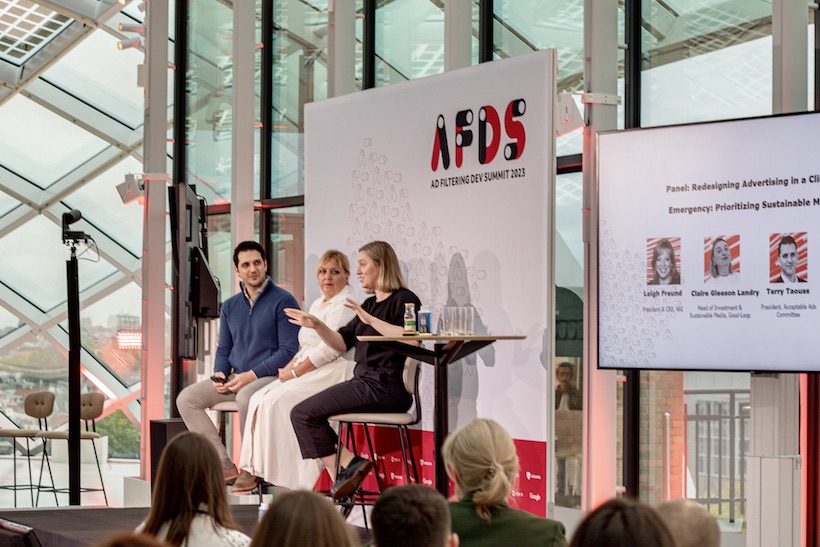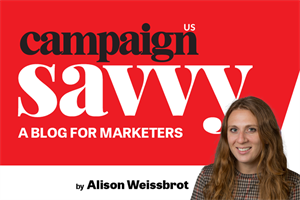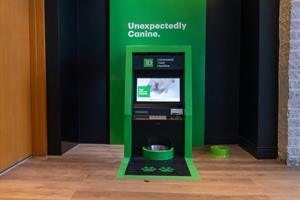Sustainability was a topic of focus as industry leaders gathered in Amsterdam at the 2023 Ad-Filtering Dev Summit sponsored by Eyeo, Google and AdGuard to discuss ad filtering, privacy tech, the future of the web and more.
“We are in the middle of a serious climate crisis,” Gertrud Kolb, chief technology officer at Eyeo, said during her opening remarks at the conference. “We all know that we have to change our behavior.”
As innovators in the technological space, it’s imperative “to think about how technology influences our daily lives,” Kolb said. Take a look at the outcome and value of those technological innovations. “The question is do we have a better life? What should technical products look like to ensure a better life for all of us?”
Prioritizing sustainable media
During a separate presentation on “Redesigning advertising in a climate emergency,” Terry Taouss, president of Acceptable Ads Committee; Leigh Freund, president and CEO of NAI; Claire Gleeson-Landry, head of investment and sustainable media at Good-Loop; and Justin Wohl, chief revenue officer at Salon.com, Snopes.com and TVTropes.org, shared insights into ways to make advertising more sustainable and ultimately better for humans and the planet.
“In the context of our ongoing climate emergency, it's critical that action be taken up and down the supply chain for the advertising industry to be more sustainable overall,” Wohl said. “Selecting the right technologies for the delivery of our content and for our advertising business is how we can do our part to reduce our carbon footprint and our emissions overall.”
As the industry moves toward more sustainable advertising, lessons can be gleaned from the privacy journey, Freund said. “It's been very hard to get companies to adopt strong privacy standards without regulation, and we're at the same place with sustainability,” she explained. “A lot of it starts with advertisers.”
All brands whether or not they are a B-corp can prioritize purpose and profit, Gleeson-Landry said. For example, Volvo not only sells rechargeable vehicles but has also built a manmade coral reef as part of its advertising campaign. “They reintroduced 81 species back into Sydney Harbour, used our green media technology to measure the emissions of their campaign and also funded coral reef restoration,” she added. “It’s a really clever way for brands to take their corporate purpose, that usually exists on the CSR pages of their website, to bring that to the foreground and leverage that because consumers care.”
In the absence of political impetus, people often look to brands for guidance. For example, Nature Valley not only features open-sourced, sustainable packaging but is also funding forest restoration. “It's all quite tangential, but it actually comes back to them demonstrating their values,” Gleeson-Landry said.
Changing the way we advertise
Sustainable innovation requires a shift in the way the industry operates. With programmatic advertising, “publishers have been told to maximize bid density in order to maximize demand for their advertising inventory,” Wohl said. “That often means sending multiple requests for the same impression opportunity to the buy side.”
However, with the recent concept of queries per second (QPS), publishers have “learned they’re sending so many requests that some of them are being thrown out,” he explained. “This is our point as an industry to take a look at the levers that we have control over and to pull them back.”
It’s equally important from a privacy perspective. “Reducing bid density and understanding where your requests are going and who’s reacting to them is also a privacy preserving technology,” Freund added. “We should be building a sustainable industry that does better for consumers, better for the environment.”
Understanding what consumers want and giving them a choice is key to creating better solutions. Rather than made-for-advertising sites (MFAs), “good quality advertising should be funding good quality content on the internet,” Gleeson-Landry explained.
MFAs offer “a terrible user experience,” Taouss added. “Even though it might be optimizing toward some advertiser metric, in the long term, it’s not what users want.”
Strengthening the industry
The truth is “without people that want to see and buy things that are seen on advertisements, you have no business,” Freund said. That means the consumer experience has to come first from a privacy and sustainability perspective.
“By selecting direct only channels and knowing the buyer for every ad impression that we sell, we are able to better ensure the privacy of our readership by telling them that their data is only going to certain known places,” Wohl said.
While there is a misconception that sustainability costs more, “ultimately it helps you deliver more efficient campaigns so you save money elsewhere,” Gleeson-Landry said. Many brands are fearful of getting sustainability wrong. That’s why “people are waiting for the guidance, standards to come in and for political insistence on it.”
No one brand can solve the problem alone. “For companies that are business partners of big brands, they're not going to do it unless the big brand tells them to do it and the big brand isn't going to do it unless their biggest competitor is,” Freund said. “Once that tipping point starts, you’ll see scale, you’ll see adoption much more rapidly.”
Once sustainability tips over into the mainstream, it will imbue itself across every element of an organization, Gleeson-Landry added.
Advertisers are in a position to shape the industry and make it more commonplace. “If the advertisers force it, everyone in the data flow below will do it all the way down to ad tech and measurement providers,” Freund said. “Ad tech companies and vendors also need to be brave in experimenting and thinking of ways of technologies and tools that can help advertisers be brave.”
Publishers are also an integral part of the solution. “News brands are the best in terms of building brands and people spending time — that quantity, discernment and choice,” Gleeson-Landry said. “They implicitly trust the advertising that’s on [their preferred news site] if it’s good quality and it doesn’t follow them around the internet.”
In the end, it’s up to publishers, advertisers and consumers to “recognize that the demand is completely essential and that everyone needs to contribute something and bring something to the table to help,” Gleeson-Landry concluded.










